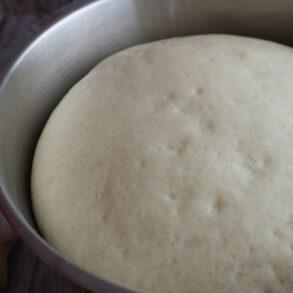
Basic yeast dough recipe
A yeast dough can be used in many ways. From it you can conjure up a delicious pastry – whether sweet or savory. Prepared correctly, it tastes airy, light and juicy at the same time. It's not difficult with this basic recipe to make yeast dough at home. But you should follow a few tips, which you can find at the top of this article.
Servings 1 large pastry / cake
Ingredients
for the dough
to coat the pastry
- 1 egg yolk room warm
- 1 tbsp milk room warm
Instructions
Preparation of the pre-dough
- Dissolve fresh yeast and sugar in lukewarm milk.
- Add flour in batches and mix to form a viscous mass.
- Cover the pre-dough with a tea towel and let it rise in a warm place for 15-20 minutes.
Preparation of the dough
- Mix softened butter, egg, egg white, sugar and salt, add to the pre-dough and mix until homogeneous.
- Add flour in portions and knead it into a soft, slightly sticky dough. Then knead the dough for about 7 - 10 minutes and let it rise covered in a warm place for 1 hour.
- Knead the dough briefly (divide it into pieces as needed if you want to make small pastry) and let it (or the dough pieces) rest for 10 - 15 minutes.
- Shape the dough as desired and let the dough piece(s) rise in a warm place for 20 - 30 minutes.
- Mix egg yolk with 1 tablespoon of milk and carefully brush the dough piece(s) with it.
- Bake the dough piece(s) in a preheated oven at 180 °C top and bottom heat, depending on the recipe.
Notes
- A pre-dough is a good way to test whether the yeast still has leavening power.
- The specified amount of flour may vary. Add the flour in portions until the dough has the right consistency. It should be very soft, not mushy, but not dry or too firm.
- If you don't plan to coat the dough with egg yolk, you can omit the egg white in the dough. In this case, you might need less flour.
- Note the detailed tips and tricks for making yeast dough yourself at the top of the post.